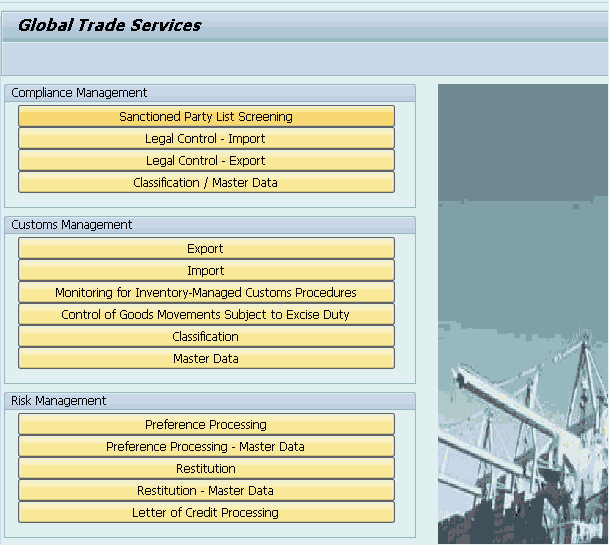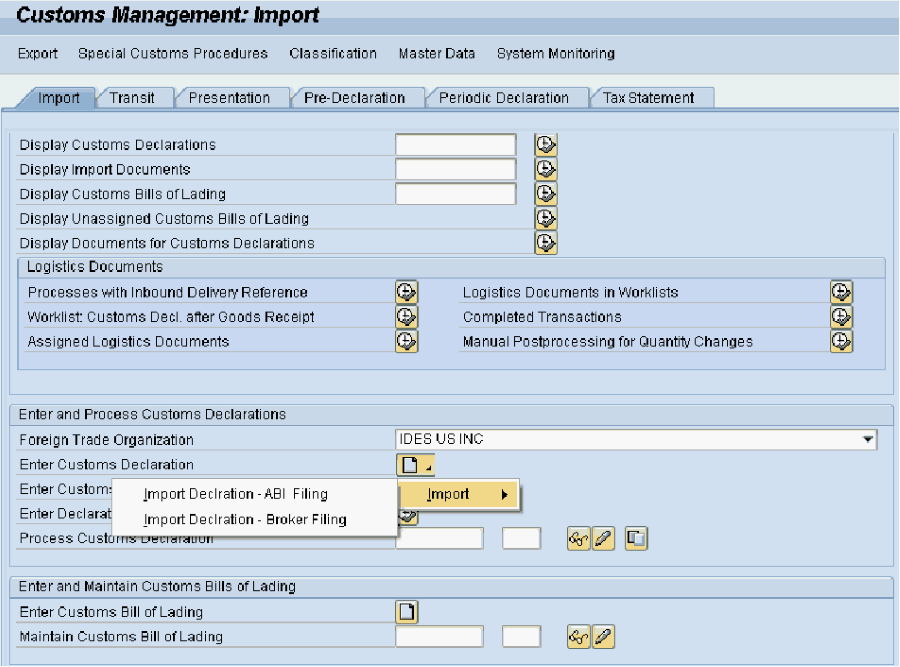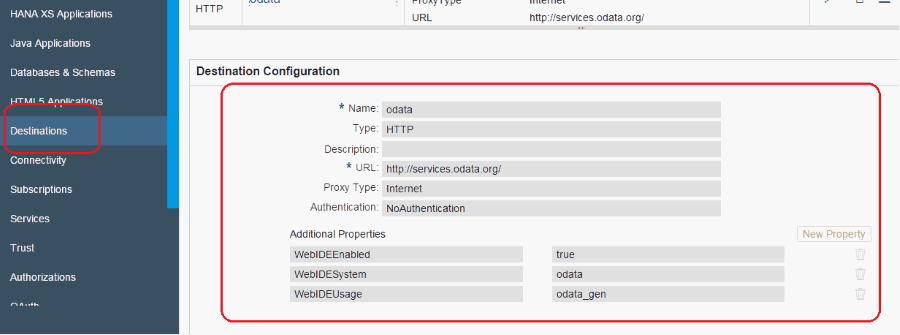Reading sample:
This main objective of this book series is to address the business needs for trade system automation with SAP Global Trade Services. This book will help you use the tool more efficiently and learn some new aspects of the system you were not familiar with.
Practical Guide to SAP GTS Part 2: Preference and Customs Management
Book 2 of the Practical Guide to SAP GTS covers customs management and preference processing. It is our hope that the multi-book format will allow you to choose the topics that you need the most.
For import and export customs, self-filing is increasingly more critical and mandated in different countries (for example the US Automated Commercial Environment and various other EU countries), this book will give you a good understanding on how to build that system foundation.
Risk Management/Preference processing
Chapter 1 will review the Preference Processing functionality in SAP GTS. As this book is primarily targeted at the user community, it will start with a review of key/common functions, including step-by-step walkthroughs.
After that will be walkthroughs and explanations of key Master Data functions, then tips for compliance with the rules and regulations for Free Trade and Preference Determination.
The Risk Management module in SAP GTS consists of three general categories:
- Preference Processing
- Restitution
- Letter of Credit Processing
Figure 1.1 shows the SAP GTS Cockpit, which includes the Risk Management section.

Preference processing user guide
Preference processing in general
What exactly does the SAP GTS term preference processing mean? When you first encounter it, the term can seem strange. Most people are more familiar with terms like free trade agreement or origin determination, which seem like a better choice. This is especially true because most people associate this aspect of SAP GTS with trade agreements.
For example, many US companies implement this part of SAP GTS specifically to comply with the North American Free Trade Agreement (NAFTA).
Preference processing—master data
Maintain products
The Maintain Products screen is one that can be accessed in many areas of SAP GTS. In the preference processing areas (see Section 1.1), you can also reach this function. Most non-preference modules also have a function to access product masters. This section will focus on those parts of a product master that relate to preference.

Preference compliance tips
General preference tips
Claiming of preference
It is a generally true statement to say that preference agreements and claiming preference status are voluntary things. You typically never have to claim preferential status. Most customs regulations allow for importing general goods without special status. For members of the World Trade Organization, this typically is referred to as claiming the Most Favored Nation (MFN) tariff.
That said, most companies are going to claim preferential status at some point, typically to reduce their duty obligation to the importing country. Furthermore, their customers may demand of them the preferential status of the product, forcing them to offer information they might otherwise not need to in order to stay competitive.
Preference processing configuration
Preference processing in SAP GTS Risk Management helps exporters fulfill all the legal requirements for customs tariff preferences and show that their goods are eligible for preferential treatment. This enables their customers to import these goods either duty-free or at a reduced rate of import duty.
Preference processing involves maintaining:
- Vendor declarations
- Materials or bills of material (BOM)
- The result of the threshold value for preferential treatment
- The threshold value of the product as compared to its ex-works price (e.g., the price quoted by the seller for delivery to the predefined location(for example, up to the buyer’s door and there onwards, it is the buyer’s responsibility)
Customs management
Companies need to have a process to manage importing goods into their country and the declarations that go along with importing. To improve efficiency, reduce costs in your compliance process, and avoid delays in customs clearance, you can automate your import declarations using functionality in SAP GTS. Depending on the country, there may be multiple declarations required.
Customs declarations overview
Imports
SAP GTS has a document called a customs declaration. While they can be created manually in SAP GTS, the typical source is from purchase orders in SAP ECC.
As a purchase order is saved in SAP ECC (transaction ME21N), the information is automatically transferred to SAP GTS, and an equivalent customs declaration document is created in the system.
In SAP GTS, you can view these customs documents in transaction /SAPSLL/MENU_LEGAL, otherwise known as the SAP GTS Cockpit. From here, head to Customs Management • Import.

SAP ECC configuration
The other aspect of customs management is the export declaration. These are very similar to import declarations but are generally tied to sales orders or deliveries. Similar to imports, these can be used to generate a paper document or self-file electronically with the US Department of Census.
General settings configuration for SAP GTS
Step 1: Define partner functions
Define partner functions that are used in customs declarations. Follow IMG menu path Global Trade Services • General Settings • Partner Structure • Define Partner Functions (see Figure 2.13). Review the partner functions that are pre-defined in the system. If needed, you can define your own custom partner function in one of two ways.
The first is by selecting one of the pre-delivered ones and clicking the Copy as this button. The other method is to create one from scratch by clicking on the "New Entries" button.
SAP GTS customs management configuration
Step 13: Map customs declaration to legal regulation
Following the activation, the document types are mapped for determination (see Figure 2.29). Follow IMG menu path Global Trade Services • Customs Management • Control Settings for Application Areas by Legal Regulation of a Legal Code.
AES in SAP GTS
Customs Management in SAP GTS (GTS) is an SAP module that you can use to standardize electronic communication processes, including customs declarations. Electronic communication in Customs Management takes place by printing messages or creating Electronic Data Interchange (EDI) messages.
You can connect SAP GTS to many different customs authorities to manage foreign trade activities.
SAP GTS can communicate and set up electronic customs processes with European, US, and Australian customs authorities and address the different filing formats, data transmission requirements, and other features. We will focus on the process used in the US between the exporter and the US customs.
ATLAS
As part of Germany’s automated ATLAS export procedure, customs declarations for exporting are registered electronically. Some of the key advantages of using ATLAS are that it expedites customs declarations, is paperless, and saves manual effort and time. You can configure SAP GTS to enable ATLAS for automating German export declarations.
SAP GTS setup for import/export self-filing
Follow menu path SAP GTS Cockpit • SAP Customs Management • SAP Customs Management – Import/Export Processing (see Figure 2.74). This shows the key functionality and setup functions for customs processing. When you click SAP Customs Management – Import/Export Processing, you reach the Operative Cockpit.
User guide
Classification
The classification function in Customs Management is very similar to the equivalent function in Compliance Management. Access the classification area through the main SAP GTS Cockpit screen as shown in Figure 2.86.

Version 11 Screen Personas and SAP Fiori
As discussed in Chapter 3, one of the key enhancements in version 11 of SAP GTS is the use of SAP Fiori Apps. Along with SAP Screen Personas, there is the potential to create a greatly improved user experience, or UX.
Below you will find information on three key areas around UX and SAP GTS:
- Setup/configuration
- Screen Personas
- Mobile apps with SAP Fiori
Setup/configuration
This section will offer high level looks at how to set up and configure both SAP Fiori and SAP Screen Personas with SAP GTS. It is not intended to be a technical guide but rather a tool you can use to build your own project roadmap.

Key technical steps:
- Create a BEx Query as RFC Function Module
- Create a ABAP Web service using NetWeaver Gateway
- Activate Gateway Client through SPRO configuration section of SAP
- Create SAP Fiori app
Create SAP Fiori app
Log into SAP Web IDE, a web application used to design and develop SAP Fiori apps. You will need to set up the OData destination to be used before connecting the service. It can be created under the Destinations function in the Wed IDE Cockpit, as seen in Figure 4.2

Screen Personas
While Screen Personas for SAP cannot be used as mobile apps, they are very powerful when used on a computer. Furthermore, they can be customized farther than SAP Fiori apps can, giving you more flexibility.
Mobile apps with SAP Fiori
SAP Fiori enablement of mobile apps has the potential to revolutionize the use and value of SAP GTS.
Tags
- customs
- gts
- management
- preference
Sign up for the newsletter and never miss any more news!
As a thank you, you will receive a 10% discount on a one-year license for our SAP learning platform.1
* Required
1. One-off and only for new customers. The voucher cannot be combined with other promotions and can only be redeemed at Espresso Tutorials GmbH.